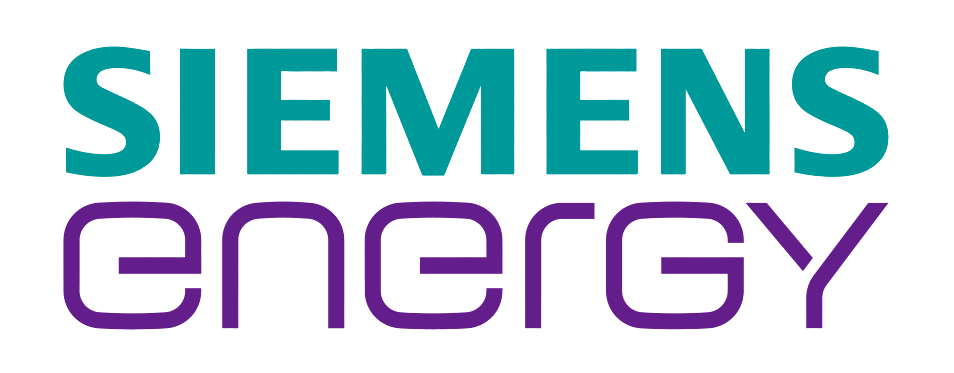Alternative Proteins in Pet Food
Listen to this Article
mins | This voice is AI generated.
mins | This voice is AI generated.
People are moving towards becoming more sustainable, this makes the demand for alternative protein products increase in both the human and pet food industry. As the global population of vegetarian and vegan food is increasing, it can be said that pets are next in the line for the consumption of meat alternatives.
Plant-based meats alternative and cultured cell-based meat alternative products are current market trends. These alternatives require new methods and technology that can help to increase our current system of production. But there are also some disadvantages to this budding industry in which the cost of the product development is the major issue. Other technical difficulties are mass production, quality control, and palatability, legal and regulatory guidance. Alternative protein is the future wave that will be playing a major role in feeding the growing population as there will be a shortage of land and other major resources. Also, sustainable food will help to reduce climate change caused by the traditional food industry.
Alternative proteins are sourced from different protein-rich ingredients. They can be plant-based, cell-based, and insect-based. As the population grows so does the food demand and these major meat alternatives are the future for both humans and pets. In the case of pets, we need to understand that they have different tastes and needs as compared to a human. Insects, animal, and plant-based proteins are good sources of protein, and it is important to blend them to ensure that the product delivers all essential amino acids dogs and cats need. Consumer views and needs for the end product are being reflected in the commercialization of these alternatives with better and enhanced sensory qualities. Pet food manufacturers now increasingly strive to simplify labels and include ingredients perceived as simpler, cleaner, and more sustainable, offering specialized nutritional support. There is continuous research going on to match the taste and texture of these non-traditional protein sources with the traditional ones.
Plant-based meat (PBM) – Soybeans, peas, lupin beans, potatoes, wheat, and corn are just a few examples of plant-based proteins that have long been utilized in human and animal diets. Others are only now becoming well-known and readily available. Fava beans, chickpeas, lentils, marrowfat peas, beans, and rapeseed are examples of developing plant-based proteins that are less often utilized on the market and are rapidly becoming embraced or are still primarily in the research stage.
While looking for new and upcoming plant-based protein in pet food, the long-term sustainability of the product should be kept in mind. In addition to environmental stability, pet manufacture needs to ensure continuous availability of the product as it rises in importance in the food supply. Quinoa, duckweed, sunflower seeds, green leaves, and microalgae are among forthcoming innovative pet food components that may satisfy these sustainability criteria. Duckweed, a simple aquatic plant belonging to the Lemnoideae subfamily, and algae are two new protein sources that are particularly fascinating. Both protein sources are appealing because, in the proper conditions, they can be produced on water and year-round. Both can thrive in locations where other crops cannot, thanks to their habitat, and hence will not compete for land with other agricultural operations.
Duckweed protein in pet food has a greater amino acid concentration than other plant proteins and is equivalent in protein content to animal proteins such as fishmeal. In a year, cultivated duckweed may provide more than 20 metric tonnes of yield on a single hectare of land, including 5 tonnes of protein. Only 3 tonnes of soy are produced. Duckweed has the drawback of not being able to be cultivated all year in colder areas.
Algae, like duckweed, might be used as an alternate protein source. More than 40 tonnes of protein may be produced by a single acre of algae. However, because algal cell walls are more robust than those of other plants, additional processing is required to get protein, and, once again, the right climate is required for year-round production.
Pulse protein isolates can be used to make cat milk because of their emulsifying qualities, absence of lactose, and heat stability; both dry and soft kibbles because of their high protein content, and dental sticks and chew bones because of their high protein content and lack of carbohydrate in pet food.
Cell-based meat (CBM): In the development of sustainable animal meat substitutes, “Cellular Agriculture” is at the forefront. It has opened a brand-new sector dedicated to the production of ‘meat’ and protein products derived from both animal and plant biological components.
According to the Pet Food Institute, there are more than 180 million dogs and cats in American households. In addition, the American Pet Products Association estimates that in 2020, Americans would spend USD 42 billion on pet meals and treats. With such a large economic basis, the growth of meat substitutes is a component of the global pet food industry’s future.
Many people working in the animal food sector predict that the development of meat substitutes will continue to grow in the pet food market. Currently, most advertised “meat” analog products are plant-based “meat” that has been designed to taste and feel like meat. The most common foundation is soy protein, with other new components added for flavor.
Currently, available technology is allowing us to incorporate lab-grown or cultured meat substitutes into our pet meals. Cost-effectiveness, unclear government restrictions, public acceptability, repeatable quality, existing culture techniques, and dependable manufacturing are some of the present obstacles that will need to be overcome before large-scale commercial production can develop. Food safety, on the other hand, should be a major focus at every stage of the manufacturing process, from cellular collection to final product marketing. As a result, regulatory frameworks must be established and implemented in tandem with these production and marketing objectives.
Insect-based- Insects are a good source of protein for both pets and people since they reproduce in large numbers, have high nutritional quality, and need very little water and land. For example, crickets are a complete protein with a useful quantity of amino acids, similar to soybeans. They’re high in dietary fibre and mainly unsaturated fat, as well as vitamins and minerals. The most commonly used insects to produce alternative proteins (refer to Exhibit 1) are:
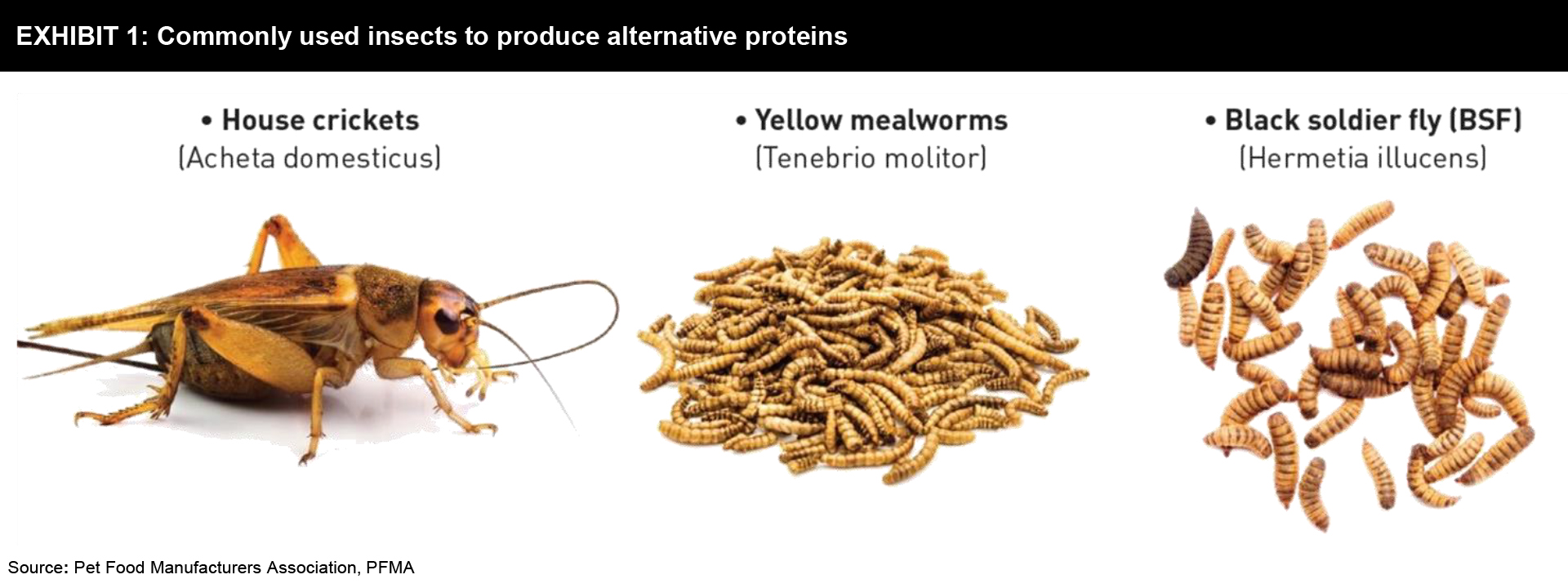
The insects are mainly rendered into high protein meals (e.g. 55% protein with 80% digestibility) and lipids (e.g. 95% purity) or made into a puree which is then frozen. Whole dried alternatives are available, but these are mainly targeted at the wild bird market.
Insects such as BSF are rich in protein and have clear potential in animal nutrition. The well-balanced amino acid profiles of certain insect ingredients are shown to be comparable to meat- and fishmeal (Spranghers et al., 2017). Due to their novel protein structure, there is a lot of interest for use of insects in diets that are intended for pets diagnosed with food intolerance or allergies.
Additionally, insects can have high fats/oils, mineral and vitamin levels, depending on what they are fed on.
Although more research is required, preliminary reports suggest that insect production at a large scale could reduce environmental impacts (less greenhouse gas emission, water, and land usage) compared to conventional livestock production. Insects are also efficient feed converters, depending on their species and the diet consumed. Mealworm and house crickets have been reported to convert some feed sources into body mass with similar efficiency to poultry.
Market research work undertaken by PROteINSECT (2016) indicates that a high percentage of consumers demonstrate the acceptability of insects as a protein source in animal feed (70% of those surveyed said that it is acceptable to feed insect protein to farmed animals). They also showed a desire for more information about insects as an alternative sustainable protein source.
Growing media attention and campaigns by farmers, academics, professional bodies (such as BVA) and pet food companies are helping to increase the acceptability of insect-based ingredients among pet professionals and owners.
Science supports insect use and although more research is needed there is already strong evidence of the benefits of using insects.
Bond Pet Foods (Boulder, Colorado)
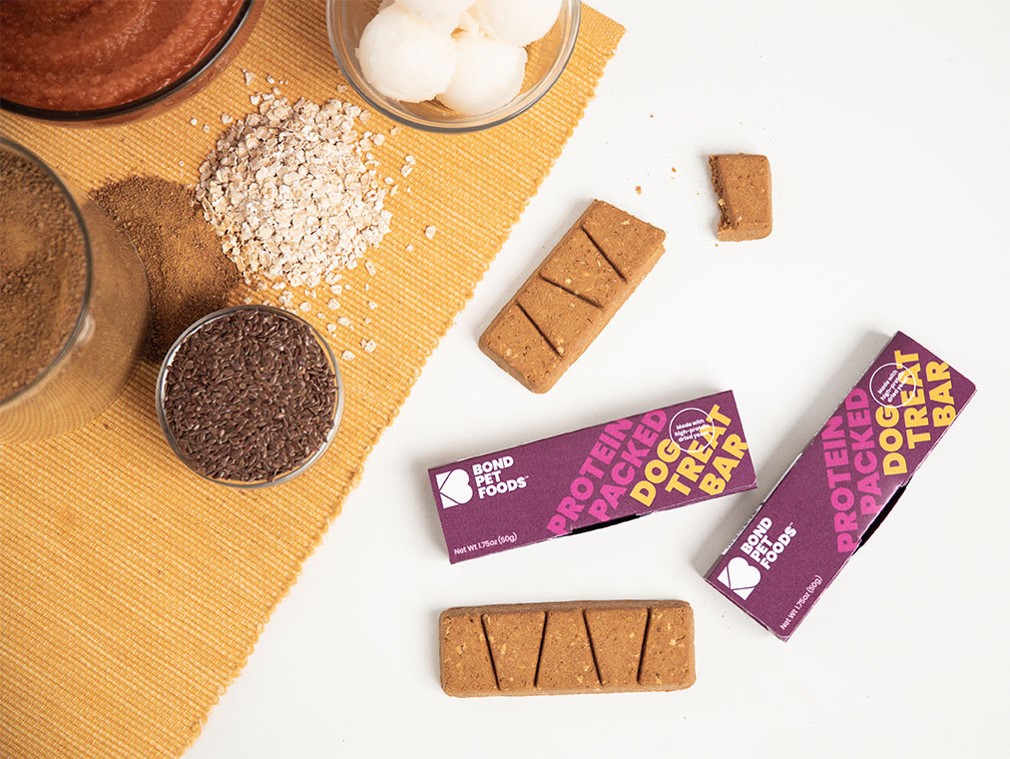 The Company has been working with biotechnology to make animal-free and protein-rich pet food. Its first product is the Protein-Packed Dog Treat Bar, a snappable, portable, and sustainable snack that provides high-quality, supplemental nutrition to a dog’s existing diet.
The Company has been working with biotechnology to make animal-free and protein-rich pet food. Its first product is the Protein-Packed Dog Treat Bar, a snappable, portable, and sustainable snack that provides high-quality, supplemental nutrition to a dog’s existing diet.
Approved by veterinary nutritionists for high digestibility and palatability, the bar is made with a novel dried yeast protein as the foundation of its recipe. While standard baked treats typically range from 12% to 20% protein, Bond’s recipe boasts a 29% minimum protein content, which can help supplement a dog’s primary diet to support sustained energy and overall health. A more sustainable alternative to other conventional animal and plant-based proteins, Bond’s selected yeast protein requires less land, water, and energy to produce.
Wild Earth (Berkeley, California)
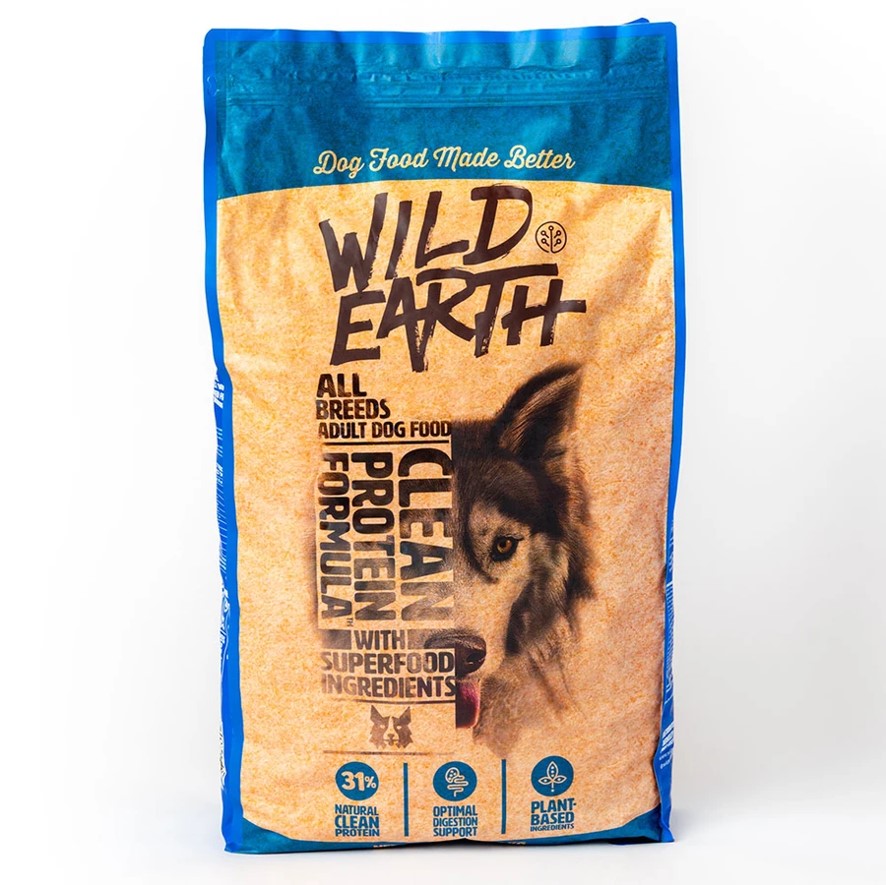 Berkeley, Calif.-based Wild Earth, a biotech startup and maker of koji-protein dog treats, uses cultured protein made from human-grade koji (Aspergillus oryzae), an ancient Asian protein and member of the fungi kingdom containing all 10 amino acids essential for dogs. It is eco-friendly and renewably sourced. The company has also launched its first complete-and-balanced diet for dogs that is meatless and utilizes yeast protein as a main ingredient and source of protein. Using a fermentation process, fungal yeasts are transformed into concentrated yeasts then incorporated into Wild Earth’s dog food as a source of protein, B vitamins, fibre, and antioxidants. According to the company, the veterinarian-developed food offers 31% complete proteins in every scoop of kibble.
Berkeley, Calif.-based Wild Earth, a biotech startup and maker of koji-protein dog treats, uses cultured protein made from human-grade koji (Aspergillus oryzae), an ancient Asian protein and member of the fungi kingdom containing all 10 amino acids essential for dogs. It is eco-friendly and renewably sourced. The company has also launched its first complete-and-balanced diet for dogs that is meatless and utilizes yeast protein as a main ingredient and source of protein. Using a fermentation process, fungal yeasts are transformed into concentrated yeasts then incorporated into Wild Earth’s dog food as a source of protein, B vitamins, fibre, and antioxidants. According to the company, the veterinarian-developed food offers 31% complete proteins in every scoop of kibble.
Because Animals (Chicago, US)
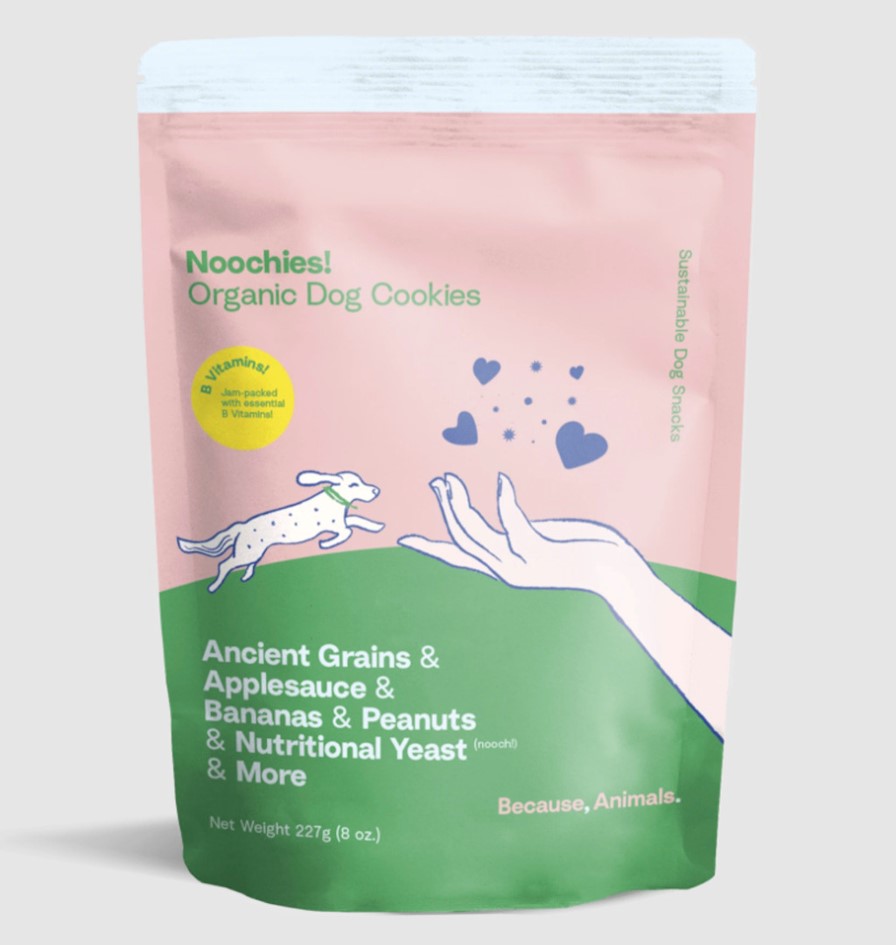 This startup is developing animal-free pet food using cell-based technology and has already managed to produce the world’s first fetal bovine serum-free (FBS) cultured meat for cats from mouse tissue. By developing a proprietary media that provides the nutrients and growth factors needed for the tissue to grow, Because Animals can ditch FBS, which is not considered cruelty-free because it involves extracting blood from pregnant cows at slaughter.
This startup is developing animal-free pet food using cell-based technology and has already managed to produce the world’s first fetal bovine serum-free (FBS) cultured meat for cats from mouse tissue. By developing a proprietary media that provides the nutrients and growth factors needed for the tissue to grow, Because Animals can ditch FBS, which is not considered cruelty-free because it involves extracting blood from pregnant cows at slaughter.
Not only does this mean that your pets don’t have to munch on something that contributes harm to other animals, but also that their food is far safer, healthier, and doesn’t destroy the planet either.
Purina (St. Louis, MO)
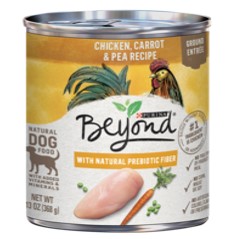 Nestlé’s brand Purina is launching a new line of pet food formulas to contribute to its overarching environmental initiatives. The new line, Beyond Nature’s Protein, will include alternative protein sources including insect proteins and plant proteins from millet and fava beans.
Nestlé’s brand Purina is launching a new line of pet food formulas to contribute to its overarching environmental initiatives. The new line, Beyond Nature’s Protein, will include alternative protein sources including insect proteins and plant proteins from millet and fava beans.
The formulations, developed by veterinarians and nutritionists, include a chicken, pig liver, and millet recipe, and an insect protein, chicken, and fava bean formula. Each recipe is available for dogs and cats. Beyond Nature’s Protein formulas are complete and balanced and consider the different nutritional needs and palatability preferences of dogs and cats. The formulas promote digestibility and high nutrient quality, according to Nestlé.
Mars Petcare (McLean, Virginia)
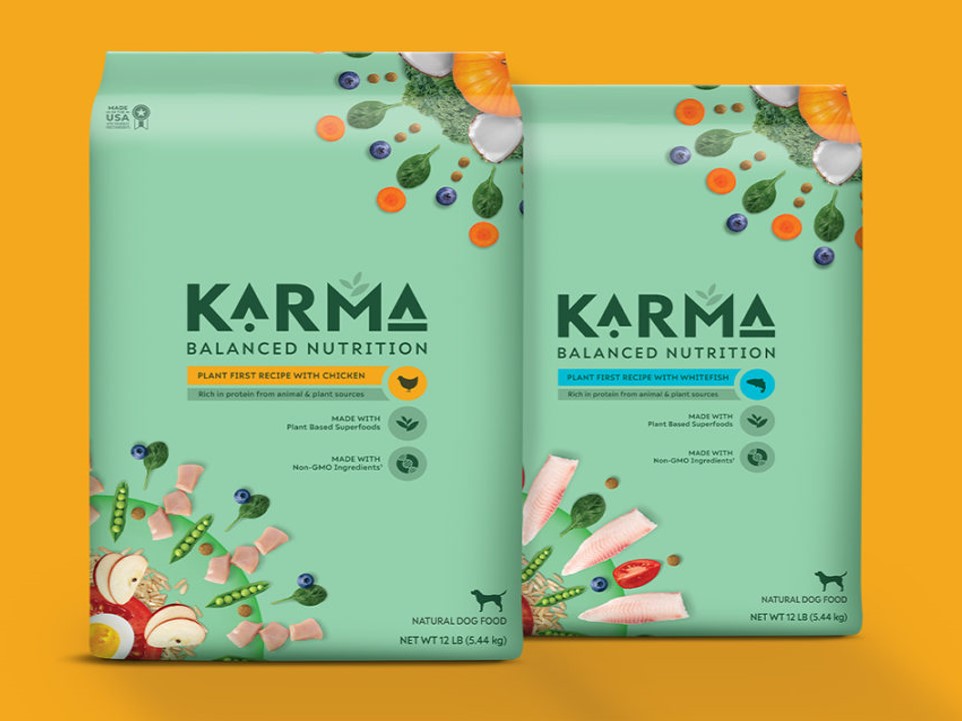 Mars Petcare has introduced a new brand of sustainability-focused dog food. Called KARMA, the new range is marketed as “plant-first” though both products in the line contain meat.
Mars Petcare has introduced a new brand of sustainability-focused dog food. Called KARMA, the new range is marketed as “plant-first” though both products in the line contain meat.
The KARMA dog food line claims to provide dogs with plant-based superfoods, with more than 60% of the recipe made up of plants. The formulas are designed to primarily incorporate whole grains and plant-based ingredients, combined with lean animal proteins and healthy fats, to create a nutritionally balanced and environmentally conscious diet for dogs.
References
Share your focus area or question to engage with our Analysts through the Business Objectives service.
Submit My Business ObjectiveOur long-standing clients include some of the worlds leading brands and forward-thinking corporations.




























